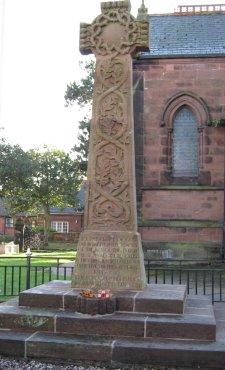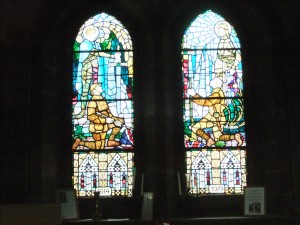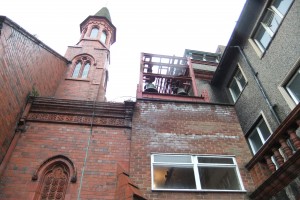World War 1 – War Memorials
Stella Young
On the 11th November 1918 the Armistice was signed and, after four years, fighting ceased at 11 am on that day. It came too late however for Private Joseph Downes of Liverpool Road in Neston. He had been in France only five weeks when he was killed on the 23rd October. The Armistice brought the fighting to an end but the Treaty of Versaillies which officially ended the war was not signed until 28th June 1919. Before the army was demobilised another Neston man, Private Benjamin Hughes of Bridge Street, died in France of pneumonia on the 18th November. He had only recently returned to France after recovering from wounds sustained at the Battle of Arras.
The response at the Front to the signing of the Armistice was reportedly somewhat muted but for those at home it was the occasion of national celebrations and Neston was no exception; the town was decorated with bunting, the church bells rang and a service was held in the local church. By December, even before the Peace treaty had been agreed, there were already discussions on how to honour the memory of the men who had died. A meeting of Church people was held in the Neston Town Hall, organised by the Vicar, Rev Brook Gwynne to discuss how it might best be done. The Rev Gwynne declared at the outset that he would make no suggestions himself but would support whichever option was favoured by the people of Neston. At this initial meeting it was suggested that the Parish church was best site for a permanent memorial although it was pointed out that a memorial chapel would require structural (and expensive) alterations to the building. Other suggestions included the provision of a Church institute, ideally with a field attached, or the endowment of a ward in the East where so many local men had died. In the end a committee was appointed to consider the options and to report on them. It consisted of members of the Local Board Finance Committee of Neston Urban District Council, with the addition of Mr Beausire, Mr Rimmer, Mr Powell and Mr Moyes. As a result of these deliberations the names of those Neston men who lost their lives are commemorated at the Parish Church and in what is now the United Reform Church in Parkgate Road.
The Parish Church of St Mary and St Helen – the Cross
On Sunday the 29th August 1920 a sandstone cross outside the Church was dedicated by the Dean of Chester.
The inscription reads –
TO THE GLORY OF GOD
AND IN IMPERISHABLE MEMORY
OF THE MEN OF THIS PARISH
(WHOSE NAMES ARE RECORDED IN THE CHURCH)
WHO LAID DOWN THEIR LIVES
IN THE GREAT WAR 1914 – 1919.
THEIR BODIES ARE BURIED IN PEACE
BUT THEIR NAMES LIVETH FOR EVERMORE.
ALSO THE MEN OF THIS PARISH
WHO LAID DOWN THEIR LIVES
IN THE GREAT WAR 1939 – 1945.
Parish Church of St Mary and St Helen – War Memorial Window
Inside the church a window in the Arts and Crafts style in the North Aisle showing St George on the left and St Michael on the right was made by Williams, Gamon and Co. to a design by Bernard Rice. Inscriptions were by Liverpool sculptor Herbert Tyson Smith.
Below the window is the inscription-
TO THE GLORY OF GOD AND IN IMPERISHABLE MEMORY OF THE MEN FROM
THIS PARISH WHO LAID DOWN THEIR LIVES IN THE GREAT WAR OF 1914 – 1919
“DEATH IS SWALLOWED UP IN VICTORY”
Gilbert Percival Gamon of Williams, Gamon and Co was the uncle of Captain Sydney Percival Gamon whose name appears on the list inscribed on each side of the window.




